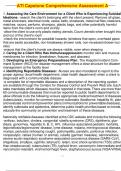ATI Capstone Comprehensive Assessment A
1. Assessing the Care Environment for a Client Who is Experiencing Suicidal
Ideations: -search the client's belonging with the client present. Remove all glass,
metal silverware, electrical cords, vases, belts, shoelaces, metal nail files, tweezers,
matches, razors, perfume, shampoo, plastic bags, and other potentially harmful
items from the client's room and vicinity
-allow the client to use only plastic eating utensils. Count utensils when brought into
and out of the client's room
-check the environment for possible hazards (windows that open, overhead pipes
that are easily accessible, non-breakaway shower rods, non-recessed shower noz-
zles)
-ensure that the client's hands are always visible, even when sleeping
2. Caring for a Client Who Has Immunosuppression: monitor skin and mucous
membranes for infection (breakdown, fissures, and abscess)
3. Developing an Emergency Preparedness Plan: The Hospital Incident Com-
mand System (HICS) for disaster management offers a clear structure for disaster
management at the facility level
4. Identifying Reportable Diseases: -Nurses are also mandated to report to the
proper agency (local health department, state health department) when a client is
diagnosed with a communicable disease
-a complete list of reportable diseases and a description of the reporting system
are available through the Centers for Disease Control and Prevent Web site. Each
state mandates which diseases must be reported in that state. There are more than
60 communicable diseases that must be reported to public health departments to
allow officials to do the following: ensure appropriate medical treatment of diseases
(tuberculosis), monitor for common-source outbreaks (foodborne: hepatitis A), plan
and evaluate control and prevention plans (immunizations for preventable diseases),
identify outbreaks and epidemics, determine public health priorities based on trends,
educate the community on prevention and treatment of these diseases
Nationally notifiable diseases: identified at the CDC website and include the following
-anthrax, botulism, cholera, congenital rubella syndrome (CRS), diphtheria, giar-
diasis, gonorrhea, hepatitis A, B, C, HIV, influenza-associated pediatric mortality,
legionellosis/legionnaires' disease, lyme disease, malaria, meningococcal disease,
mumps, pertussis (whooping cough), poliomyelitis, paralytic, poliovirus infection,
nonparalytic, rabies (human or animal), rubella (german measles), salmonellosis,
severe acute respiratory syndrome-associated coronavirus disease (SARS-CoV),
shigellosis, smallpox, syphilis, tetanus/C. tetani, toxic shock syndrome (TSS) (other
than streptococcal), tuberculosis (TB), typhoid fever, vancomycin-intermediate and
vancomycin-resistant, viral hemorrhagic fever, staphylococcus aureus (VISA/VRSA)
, ATI Capstone Comprehensive Assessment A
5. Identifying a Prescription to Clarify With the Provider: -caused by damage to
sensory nerve fibers resulting in numbness and pain
**peripheral neuropathy includes focal neuropathies, caused by acute ischemic
damage or diffuse neuropathies, which are more widespread and involve slow,
progressive loss. This can lead to complications (foot deformities, ulcers).
**autonomic neuropathy can affect nerve conduction of the heart (exercise intol-
erance, painless myocardial infarction, altered left ventricular function, syncope),
gastrointestinal system (gastroparesis, reflux, early satiety), and urinary tract (de-
creased bladder sensation, urinary retention). It affects the autonomic nervous
system, which minimizes manifestations of hypoglycemia (diaphoresis, tremors,
palpitations), which can be dangerous for the client
-clients who have impaired sensory perception might not feel numbness, pain, or
burning
6. managing adverse effects of risperidone: orthostatic hypotension
-nursing actions: monitor blood pressure and heart rate for orthostatic changes
-client education: change position slowly
7. placing a client in side-lying position: -position clients, especially those who
are unable to move themselves, so that they maintain good body alignment. Fre-
quent position changes prevent discomfort, contractures, pressure on tissues, and
nerve and circulatory damage, and they stimulate postural reflexes and muscle tone
-use pillows, bath blankets, hand rolls, boots, splints, trochanter rolls, ankle support
devices, and other aids to maintain proper body alignment
8. preparing for a sterile dressing change: do not turn your back on a sterile field
9. teaching care seat safety: motor vehicle injury
-place infants and toddlers in a rear-facing car seat until 2 years of age or until
they exceed the height and weight limit of the car seat. They can then sit in a
forward-facing car seat
-use a car seat with a five-point harness for infants and children
-all car seats should be federally approved and be placed in the back seat, which is
the safest place in the vehicle
-infants and toddlers remain in a rear-facing car seat until the age of 2 years or the
height recommended by manufacturer
-toddlers over the age of 2 years, or who exceed the height recommendations for
rear-facing car seats, should use a forward-facing car seat until they reach the height
and weight requirements for a booster seat
-newborn infants should be placed in a federally approved car seat at a 45 degree
angle to prevent slumping and airway obstruction. The car seat is placed rear facing




